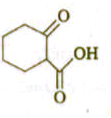Which of the following acid on decarboxylation does not from an aromatic hydrocarbon
Phenylacetic acid
Salicylic acid
Ortho toluic acid
Benzoic acid
The correct Answer is:B
To determine which acid does not form an aromatic hydrocarbon upon decarboxylation, we will analyze each of the given acids step by step.
Step 1: Understand Decarboxylation
Decarboxylation is the process of removing a carboxyl group (-COOH) from a compound, resulting in the release of carbon dioxide (CO2). This reaction typically requires a strong base, such as soda lime (a mixture of sodium hydroxide and calcium oxide).
Step 2: Analyze Each Acid
1. Phenyl Acetic Acid:
- Structure: C6H5-CH2-COOH
- Upon decarboxylation, the -COOH group is removed, resulting in the formation of benzene (C6H6) and the release of CO2.
- Result: Forms an aromatic hydrocarbon.
2. Salicylic Acid:
- Structure: C6H4(OH)COOH (with -OH group on the benzene ring)
- The presence of the -OH group allows for intramolecular hydrogen bonding, which stabilizes the molecule and prevents decarboxylation.
- Result: Does not undergo decarboxylation, hence does not form an aromatic hydrocarbon.
3. Ortho-Toluic Acid:
- Structure: C6H4(CH3)COOH (with -CH3 group on the benzene ring)
- Upon decarboxylation, the -COOH group is removed, resulting in the formation of a methyl-substituted benzene (C6H5-CH3).
- Result: Forms an aromatic hydrocarbon.
4. Benzoic Acid:
- Structure: C6H5COOH
- Upon decarboxylation, the -COOH group is removed, resulting in the formation of benzene (C6H6).
- Result: Forms an aromatic hydrocarbon.
Conclusion
After analyzing all the acids, we find that salicylic acid does not form an aromatic hydrocarbon upon decarboxylation due to the stabilization from intramolecular hydrogen bonding.
Final Answer
Salicylic Acid is the acid that does not form an aromatic hydrocarbon upon decarboxylation.
---
Decarboxylation is the process of removing a carboxyl group (-COOH) from a compound, resulting in the release of carbon dioxide (CO2). This reaction typically requires a strong base, such as soda lime (a mixture of sodium hydroxide and calcium oxide).
- Structure: C6H5-CH2-COOH
- Upon decarboxylation, the -COOH group is removed, resulting in the formation of benzene (C6H6) and the release of CO2.
- Result: Forms an aromatic hydrocarbon.
- Structure: C6H4(OH)COOH (with -OH group on the benzene ring)
- The presence of the -OH group allows for intramolecular hydrogen bonding, which stabilizes the molecule and prevents decarboxylation.
- Result: Does not undergo decarboxylation, hence does not form an aromatic hydrocarbon.
- Structure: C6H4(CH3)COOH (with -CH3 group on the benzene ring)
- Upon decarboxylation, the -COOH group is removed, resulting in the formation of a methyl-substituted benzene (C6H5-CH3).
- Result: Forms an aromatic hydrocarbon.
- Structure: C6H5COOH
- Upon decarboxylation, the -COOH group is removed, resulting in the formation of benzene (C6H6).
- Result: Forms an aromatic hydrocarbon.
After analyzing all the acids, we find that salicylic acid does not form an aromatic hydrocarbon upon decarboxylation due to the stabilization from intramolecular hydrogen bonding.
Salicylic Acid is the acid that does not form an aromatic hydrocarbon upon decarboxylation.
Topper's Solved these Questions
Similar Questions
Knowledge Check
Which of the following decarboxylate on heating?
A B
B C
C D
D
Which of the following can decarboxylated most easily?
ACH3CH2CH2COOHBCH3−CH=CH−COOhC D
D
Which of the following is aromatic ?
A B
B C
C D
D